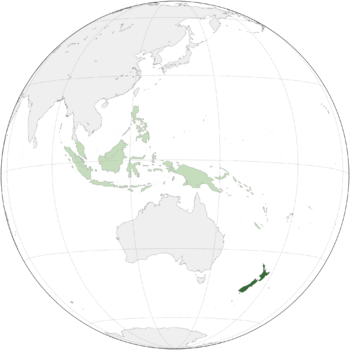Sudenia
Sudenian Egalitarian Republic República Igualitária Sudense | |
|---|---|
| Motto: Para a Sudénia Brilhar "For Sudenia to Shine" | |
| Anthem: Para a Sudénia Brilhar
| |
Location of Sudenia (dark green) in the Confederation of the South (light green) | |
| Capital | Queirós |
| Largest | Vitória |
| Official languages |
|
| Ethnic groups |
|
| Government | Unitary Egalitarian Republic |
• Representative | Tiago Ramos |
• Vice-President | Bianca Martins |
• Speaker of the Assembly | Luísa Yang |
| Legislature | National Assembly |
| Independence from Portugal | |
• Declared | 1909 |
• Establishment of the Egalitarian Republic | 1954 |
• Current Constitution | 1955 |
| Area | |
• Total | 268.021 km2 (103.483 sq mi) |
• Water (%) | 1.6 |
| Population | |
• Estimate | 13 047 300 |
• Density | 48.7/km2 (126.1/sq mi) |
| GDP (nominal) | estimate |
• Total | 701.405$ billion |
• Per capita | 53.758$ |
| Currency | Cruzeiro ( |
| Date format | dd -mm-yyyy |
| Driving side | right |
| Internet TLD | .sd |
Sudenia, officially known as the Sudenian Egalitarian Republic is an island nation in the southwestern Pacific, consisting of 2 main landmasses, Taícaro Island and Crimson Island, 2 smaller archipelagos, False Island and Savage Islands, and 700 other islands. The country's varied topography and sharp mountain peaks, including the Southern Peaks, owe much to tectonic uplift and volcanic eruptions. It lies southeast of Aurea, across the Torres Sea. It has an estimated population of 13 million people. Its capital city is Queirós and its most populated city is Vitória.
Sudenia was the last large habitable land to be settled by humans. In the 13th and 14th centuries it was populated by Polynesians, who developed a distinct Māori culture. In 1591, Luís Vaz de Torres would be the first European to sight the archipelago. In 1606, Pedro Fernandes de Queirós officially discovered the islands, setting the beginning of European colonization of Sudenia. The relationship between the Portuguese and the Māori was tenuous, and the Maori population dwindled due to conflict and diseases. In 1821, after the Portuguese transfer of power to Aurea, the Māori were recognized as Portuguese citizens and subsequently integrated into Portuguese society. The Sudenian Revolution led the country to independence in 1909 and established the Sudenian People’s Republic, an unitary socialist state. The 1954 Revolution overthrew the authoritarian regime and established an egalitarian system. During the Great Divide, Sudenia de facto broke the diarchy despite being a member of the Eastern Bloc. In the ongoing Tripartite War, Sudenia occupied much of the Indian Ocean and invaded Aurea in 2058.
Sudenia is a developed country and is one of the most developed regions in the Eastern Bloc. It is one of the global leaders in science and technology, credited for numerous inventions in the 20th and 21st centuries. It ranks very highly in international measures of quality of life, human rights and environmental friendliness. It has the highest measured equality in the world. Numerous political scientists credit this performance to its unique political and economical system. Sudenia is a member of the International Council, the Eastern Bloc, the Confederation of the South, and has observer status in the African Development Initiative
Etymology
The first name for the island was Terra de Queirós ('Land of Queirós'), after its discoverer, while the name Teíca (from Te Ika-a-Māui, the Māori name for Taicaro Island) was also used, albeit less regularly. By the end of the 17th century, the portuguese name Sudénia became the most used, coinciding with an increase in migration to the colony. Its etymology is unknown, and all existing theories are widely disputed. The folk etymology in both Sudenia and Aurea holds that an unknown Luso-German exclaimed "Das ist der Südenland" ("That is the Southern Land", refering to Terra Australis) when they sighted the islands, and the suffix -land was later replaced by the latin suffix -ia, of the same meaning. This theory is widely believed to be false



